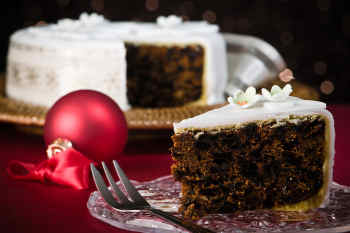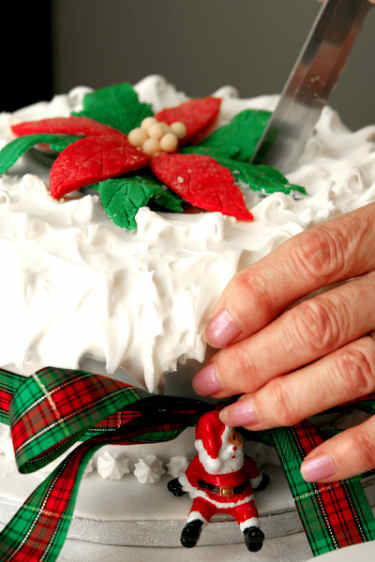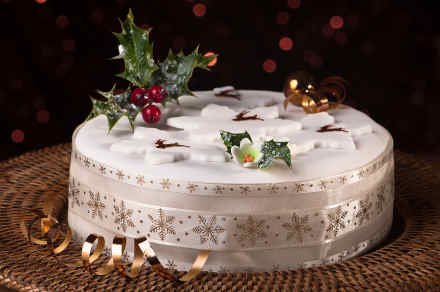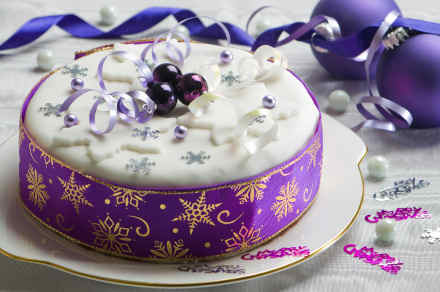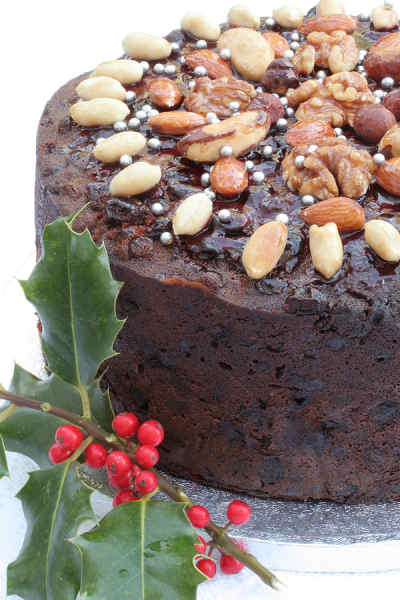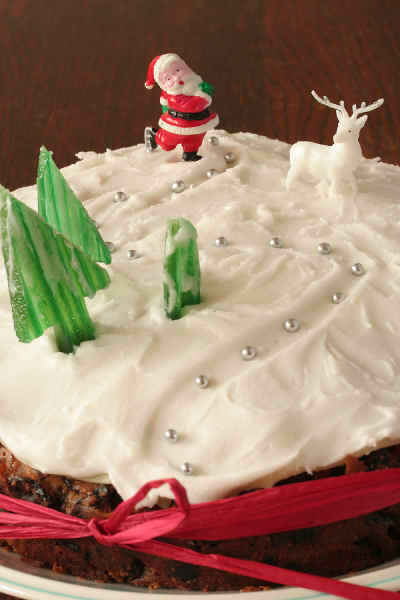

Traditional Christmas Cake RecipeHere's a recipe for a delicious, traditional Christmas cake. It's bursting with dried fruit and covered with marzipan and fondant icing. As with all Christmas cakes, this one improves with keeping. You should aim to make it at least a month before Christmas, and up to three months before. You may also make the cake early and freeze. Serve as a plain fruit cake (see photos at the bottom of the page), or cover with marzipan and fondant icing or royal icing for a traditional cake. I've broken down our instructions to give as much detail as possible for those not confident in Christmas cake making. I've also provided a number of photos of differently-decorated Christmas cakes for inspiration!
Cake Ingredients: I have suggested a combination of dried fruit below, but you may vary proportions and even the individual types of fruit as long as you ensure that the total quantity is 825g (1lb 13oz). The ingredient list looks long, but don't panic! Measure out the dried fruit and chopped nuts first into one bowl, and then the spices into a small dish. It will seem less daunting that way! 50g (1 3/4 oz) chopped mixed peel Zest of 1 orange 4 eggs, beaten 225g (8oz) plain (all-purpose) flour 1 tsp ground cinnamon The day before, or early morning: Put all the first section of ingredients into a large bowl and stri well to mix. Cover with clingfilm (plastic wrap) and leave to soak overnight, or for at least 4 hours. Prepare your tin: You will need a 20cm (8in) round tin or a 18cm (7in) square tin. Grease and line the base and sides with a double thickness of greaseproof paper, or use 2 pre-formed greaseproof paper cases. Cut a double thickness band of brown paper a few inches higher than the tin and wrap and tie it round the tin with ordinary kitchen string. Preheat the oven to 150C, 300F, Gas Mark 2 Make the batter: Beat the butter and sugar together until light and fluffy. Beat in the orange zest. Add the eggs and ground almonds a little at a time, beating well. Incorporate the flours and fruit: Sift the flours together with the spices and salt. Add about one quarter to the batter, followed by a quarter of the fruit, folding gently to combine. Continue adding a quarter of each until everything is in the bowl. NB: It is important to fold gently and not to beat at this stage! Pour the mixture into the tin and try to press the fruit down so that it doesn't stick out about the top of the cake mixture. Bake: Bake on the middle shelf of your oven for an hour. Lower the temperature to 140C, 275F or Gas Mark 1 and bake for a further 1 1/2 to 2 hours. Test by inserting a skewer into the centre of the cake - it should come out clean. If there is batter on the skewer, cook for a further 5 minutes and test again. Cool and store: Remove the cake from the oven and allow it to cool completely in the tin. Remove from the tin but keep the cake in the greaseproof paper, as this will help to keep it moist. Wrap in more greaseproof paper, then in foil. Store in a cool place for up to 3 months, or freeze if you prefer. If freezing, thaw the cake completely before adding marzipan (almond paste) and icing. Icing Your Christmas CakeChristmas cakes are traditionally iced with royal icing - a thick white icing sugar paste which sets to be completely hard and is usually spread over the cake first, then decorated with an icing bag and nozzles. More popular these days is fondant icing, especially as you can buy it ready made and ready rolled. Both icing methods are described below. Whichever icing method you choose, you will first need to cover the cake with marzipan, using a layer of jam to help the marzipan stick. Marzipan (almond paste) layer: Start 1-2 days before you intend to ice the cake! 4-5 tbsp apricot jam Mix the apricot jam with the water or brandy and heat gently in a small saucepan until it bubbles. Sieve to remove lumps then allow to cool. Place cake on your icing turntable, cake stand or cake board. If necessary, trim the top of the cake flat. Dust your surface and rolling pin with icing sugar and roll out the marzipan. Use the original cake tin as a guide to cutting a piece which will fit the top of the cake. Brush the top of the cake with the glaze and then gently lower the marzipan in place. Re-roll the scraps and cut a straight rectangular piece which will fit around the edges of the cake. You can measure the perimeter of the cake using a piece of string. The more even and straight you make this piece, the more professional your cake will look, so take care! Glaze the sides of the cake and apply, smoothing the joins with your fingers. You may wish to use the rolling pin to flatten the top of the cake lightly. Leave the cake in a cool, dry place for a day or two to allow the marzipan to settle and dry. Fondant icing: 750g (1lb 10oz) fondant icing Knead the fondant icing lightly to make it pliable. Roll out on a dusted work surface into a circular or square shape at least 2 inches larger than the total surface of the cake, top and sides. Using the rolling pin to help, lift the icing onto the cake and position carefully. Gently mold the icing over the edges of the cake and trim off the excess where it meets the cake board. Re-roll the scraps and use to decorate the cake, using icing cutters or a small knife to cut leaves, snowflakes etc. Royal icing: 750g (1lb 10oz) royal icing, bought in packets or made by whisking 3 egg whites and adding, a little at a time, up to 750g (1lb 10oz) of well-sieved icing sugar (confectioners' sugar). You can add 1-2 tsp glycerine to keep the icing more pliable if you like, and you may not need to add all the icing sugar. Aim for a soft peaks consistency if you want to spread the icing, and a stiff peaks consistency for piping. You may want to divide the icing - say two thirds soft peak and one third stiff peak - and keep the piping proportion in an airtight container to prevent it drying out before use. Spreading royal icing is easier if you have a jug of very hot water, a palette knife and a clean cloth to hand. Spoon a large quantity of icing onto the centre of the cake then begin to spread it out using the palette knife, cleaning it and warming it often in the hot water. It is hard to achieve a perfect finish - beginners may want to aim for a snow-storm effect on the cake! Christmas Cake InspirationTo help you decide how to present your cake, I have found some photos and suggestions for inspiration.
Back to Christmas Recipes |
|
Contact Us Privacy Statement Site Map Disclaimer A Small Publishing Website
